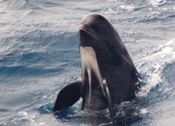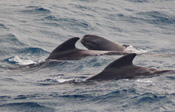Long-finned Pilot Whale (Globicephala melas)
Status | Taxonomy | Species Description | Habitat | Distribution |
Population Trends | Threats | Conservation Efforts | Regulatory Overview |
Key Documents | More Info
|
 Long-finned Pilot Whale (Globicephala melas) Photo: Howard Goldstein, courtesy of Scripps Institution of Oceanography/ UCSD and R/V Roger Revelle |
|
Did You Know? · Long-finned pilot whales scientific name (Globicephala melas) is derived from the Latin word globus for "globe" and the Greek words kephale for "head" and melas for "black." |
|
|
|
 Long-finned Pilot Whale (Globicephala melas) Photo: Howard Goldstein, courtesy of Scripps Institution of Oceanography/ UCSD and R/V Roger Revelle |
Status
MMPA - Long-finned pilot whales, like all marine mammals, are protected under the MMPA.
Taxonomy
Kingdom: Animalia
Phylum: Chordata
Class: Mammalia
Order: Cetacea
Family: Delphinidae
Genus: Globicephala
Species: melas
The short-finned pilot whale (Globicephala macrorhynchus) is another species of pilot whale.
Species Description
Long-finned pilot whales are one of the largest members of the dolphin family. Males can reach lengths of about 25 ft (7.6 m) and weigh as much as 5,000 lbs (2,300 kg), while females are generally smaller, reaching lengths of up to 19 ft (5.8 m) and weighing as much as 2,900 lbs (1,300 kg).
Long-finned pilot whales are wide-ranging, medium-sized animals that have a stocky, sturdy body. Their head has a large bulbous or squarish "melon". This melon varies with age and sex, and in some animals it can develop a prominent crease. The broad-base low-profile "dorsal" fin is thick, heavily falcate, lobed, and is located about a third of the body length behind the head. As the animals mature, their dorsal fin becomes broader and rounder. These whales have a pair of long, tapered, sickle-shaped "pectoral flippers" that give this species its common name. Long-finned pilot whales are dark black in coloration, but sometimes can appear dark gray or brownish. This species has pale grayish or whitish marks, such as a diagonal eye-stripe, or blaze, that extends from behind the eye and up towards the dorsal fin, a large "saddle" behind the dorsal fin, and an anchor-shaped patch that starts at the throat and extends to the uro-genital region on its ventral side.
Long-finned pilot whales are commonly seen in tight, sociable pods and sub-groups (usually containing more females than males) of usually 10-20 (less than 50) individuals, but have been reported in loose aggregations of several hundred or even up to a thousand animals. Studies have shown that these established pods are maternally-based. The strong social structure of these animals has been implicated in mass strandings on beaches. When at the surface, these gregarious whales will often display various active behaviors such as "breaching", "fluking", "lobtailing", and "spyhopping". They are also regularly seen resting or logging at the surface in a "chorus-line" or "stacked" formation, and sometimes approach vessels moving at slow speeds. This species has a small, strong, low bushy blow that is often visible. They also frequently arch their bodies exposing their dorsal fin and "tailstock" when rolling at the surface, as well as lift their "flukes" before diving.
Long-finned pilot whales are sometimes referred to as "blackfish," a group of cetaceans of the subfamily Globicephalinae, that also includes false killer whales, pygmy killer whales, melon-headed whales, Risso's dolphins, and short-finned pilot whales. They are known to associate with a variety of other dolphin and whale species, and sometimes even sharks.
The short-finned pilot whale is another species of pilot whale that appears similar to the long-finned pilot whale. The two species differ slightly in physical size, morphology, features, coloration, and pattern. In the field and at sea, it is very difficult to distinguish between the two species. The geographic distribution and range for these species may overlap in some areas.
Long-finned pilot whales are capable of diving to depths reaching at least 1,968 ft (600 m) for 10-16 minutes to feed on fish (e.g., cod, dogfish, hake, herring, mackerel and turbot), cephalopods (e.g. squid and octopus) and crustaceans (e.g., shrimp). Most feeding occurs at night in deep water between depths of 656-1,640 ft (200-500 m). Similar to other members of the delphinid family, long-finned pilot whales echolocate when foraging for prey. In comparison to other delphinids, pilot whales have very few teeth (16-26 peg-like teeth in each jaw), which may be an evolutionary adaptation to consuming large amounts of soft squid.
Males become sexually mature at 12-13 years and females at 8 years. Breeding and mating usually takes place between the months of April and September in the North Atlantic, and October and April in the Southern Hemisphere. Every 3-6 years a single calf is born after a gestation period of 12-16 months. This is one of the longest known birth intervals of all cetaceans. At birth, calves measure about 5-6.5 ft (1.6-2 m) and weigh about 165 lbs (75 kg). After 18-44 months, the calf stops nursing and is weaned by the cow. Older and/or unreproductive females will assist in caring for calves in the social group. The lifespan for males is 35-45 years, and for females is at least 60 years.
Habitat
Long-finned pilot whales prefer deep pelagic temperate to subpolar oceanic waters, but have been known to occur in coastal waters in some areas. Larger aggregations of animals have been documented on the continental edge and slope, depending on seasonality. This species has been described as "anti-tropical."
 Long-Finned Pilot Whale Range Map (click for larger view PDF) |
Distribution
Three distinct populations or subspecies of long-finned pilot whales are recognized: Southern Hemisphere (Globicephala melas edwardii), North Atlantic (Globicephala melas melas), and an unnamed extinct form in the western North Pacific. In the Southern Hemisphere, their range extends from 19°-60° S, but they have been regularly sighted in the Antarctic Convergence Zone (47°-62° S) and in the Central and South Pacific as far south as 68° S. Their distribution is considered circumpolar, and they have been documented near the Antarctic sea ice. They have been associated with the colder Benguela and Humboldt Currents, which may extend their normal range, as well as the Falklands. The southern subspecies range includes Cape Province (South Africa), Chile, southern Australia, New Zealand, and Sao Pablo (Brazil). In the Northern Hemisphere, their range includes the U.S. east coast, Gulf of St. Lawrence, the Azores, Madeira, North Africa, western Mediterranean Sea, North Sea, Greenland and the Barents Sea. In the winter and spring, they are more likely to occur in offshore oceanic waters or on the continental slope. In the summer and autumn, long-finned pilot whales generally follow their favorite foods farther inshore and on to the continental shelf.
Population Trends
Because it is impossible to distinguish long-finned pilot whales from short-finned pilot whales at sea, NMFS estimates abundance for both species combined. The most recent estimate is approximately 25,000-31,000 animals for the Western North Atlantic stock of both species. In the Southern Hemisphere, there are an estimated 200,000 long-finned pilot whales in Antarctic waters, and at least 750,000 others in the Northern Hemisphere (North Atlantic). An un-named subspecies was found in Japanese waters of the North Pacific, but is now considered extinct.
Threats
Bycatch to fishing gear is the primary threat to pilot whales. Long-finned pilot whales are entangled, incidentally taken, or interact with a number of fishing gear, that include gillnets, longlines, and trawls. Whalers benefited from pilot whales strong social structure (which made them susceptible to various threats), by driving and herding them together into tight groups. In the North Atlantic, this species was harpooned by American sperm whalers during the 19 th and 20 th centuries, and targeted (for its meat, blubber, and oil) in a drive fishery in Newfoundland. Currently shore-based hunters in the Faroe Islands (Denmark) continue to directly target long-finned pilot whales. Drive fisheries for this species also historically occurred in the Falkland Islands, Greenland, Iceland, Norway, Scotland (Orkney Islands and Hebrides Islands) and the U.S. (Cape Cod, Massachusetts). Morbillivirus' have affected pilot whales in the North Atlantic, and this species could potentially spread this disease to other marine mammal species that often associate with them. Also threatening this species are heavy metals, pesticides, pollutants, and various contaminants in the marine environment that have been found in this species' blubber. These contaminants could present a major toxicity problem as they accumulate and pass through the marine food chain.
Conservation Efforts
The IUCN Red List of Threatened Species ![]() considers this species "Low Risk Least Concern."
considers this species "Low Risk Least Concern."
In 2005, NMFS convened the Atlantic Pelagic Longline Take Reduction Team to address bycatch of both short-finned and long-finned pilot whales in the mid-Atlantic region of the Atlantic pelagic longline fishery. The team submitted their recommendations to NMFS in 2006. A proposed rule to implement the pelagic longline take reduction plan was published on June 24, 2008.
Regulatory Overview
This species is protected under the Marine Mammal Protection Act of 1972 as amended.
Key Documents
(All documents are in PDF format.)
| Title | Federal Register | Date |
|---|---|---|
| Draft Pelagic Longline Take Reduction Plan | n/a | 06/08/2006 |
| Stock Assessment Reports | n/a | various |
- NMFS Southwest Fisheries Science Center Pilot and False Killer Whale Information
- Pelagic Longline Take Reduction Team
- Listen to Pilot Whale Sounds
- Mass Stranding in North Carolina, January 2005
- Ocean Biogeographic Information System (OBIS-SEAMAP) Long-finned Pilot Whale Species Profile

References
- Reeves, R. R., P. A. Folkens, et al. (2002) Guide to Marine Mammals of the World. New York, Alfred A. Knopf. p. 440-443.
- Jefferson, T. A, M. A. Webber, and R. L. Pitman. (2008). Marine Mammals of the World, A Comprehensive Guide to their Identification. Amsterdam, Elsevier. p. 164-166.
- Shirihai, H. and B. Jarrett (2006). Whales, Dolphins and Other Marine Mammals of the World. Princeton, Princeton University Press. p.82-84.